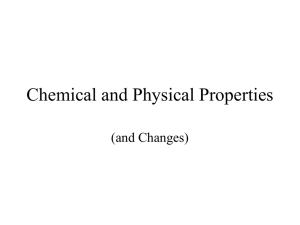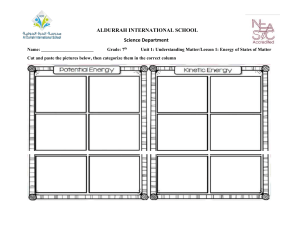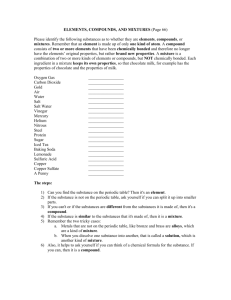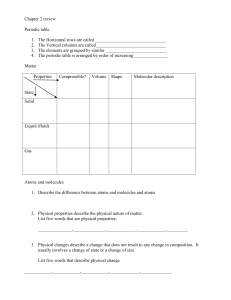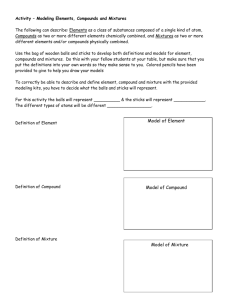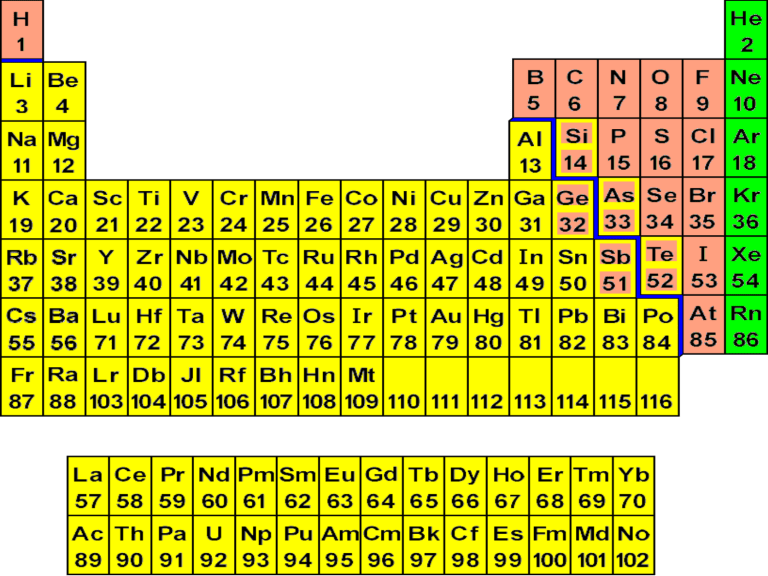
Bellringer # 6 1. What is matter? 2. How would you classify matter? Complete the right column of the table below, using the following names: boron, bromine, calcium, magnesium, neon, nitrogen, silicon, sulfur, zinc. Today, there are rules for how a newly discovered element is to be named. However, in earlier times, elements were named for people, places, and foreign words, among other things. Match each element to how it was named. You may also use an element’s symbol as a clue. Write the correct letter in the space provided. ___ Berkelium (Bk) a. Noble Prize winner who studied relativity ___ Curium (Cm) b. Latin name (ferrum) ___ Einsteinium (Es) c. powerful mythological beings ___ Gold (Au) ___ Iodine (I) d. home of the university in California where the element was first made e. Greek word for violet (iodes) ___ Iron (Fe) f. Nobel Prize winner who studied radioactive elements g. Greek word for hidden (kryptos) ___ Titanium h. Latin name (aurum) ___ Krypton (Kr) Bellringer #7 Do you think there are elements inside the human body? If yes, list several examples. Chapter 2 Overview Matter and atoms elements distinguishes between elements and compounds. Molecules and chemical formulas the differences between pure substances and mixtures. Physical and chemical properties The concept of density Physical and chemical changes of matter Chapter 2 – Matter Key Ideas 〉 How can matter be classified? 〉 Why are carbon and copper classified as elements? 〉 How are elements related to compounds? 〉 What is the difference between a pure substance and a mixture? What is matter? Matter is anything that has mass and takes up space. Chemistry is about the study of matter and its changes. Many items that you use each day are chosen for their chemical properties. Examples: soaps, foods, carbonated drinks, gasoline. Questions? Is the air that you breath matter? Is light matter? yes NO Is sound matter? NO Light and sound are not considered matter because they have no mass or volume. 〉How 1. can matter be classified? One important part of Chemistry is classification. Look at Figure 1 on page 45. 〉 One useful way to classify matter is based on what makes up the matter. Every sample of matter is either an element, a compound, or a mixture. Example: gold is an element, water is a compound, and vegetable salad is a mixture. Elements 〉 Why are carbon and copper classified as elements? 〉 Each element is made of one kind of atom. element: a substance that cannot be separated or broken down into simpler substances by chemical means atom: the smallest unit of an element that maintains the properties of that element Elements are represented by symbols. The symbols are either one capital letter or one capital and one lowercase letter. Examples: C=Carbon, Ne=Neon Atoms that make up a molecule act as a unit. Atoms can join to make millions of molecules just as letters of the alphabet combine to form different words. Molecule: the smallest particle of a substance that has all of the chemical properties of that substance A molecule is made up of one atom or two or more atoms bonded together Look at Figure 4 on page 47. Compounds 〉 How • are elements related to compounds? Each molecule of a compound contains two or more elements that are chemically combined. • 〉 Elements combine chemically to form a compound. Compound: a substance made up of atoms of two or more different elements joined by chemical bonds Example: Water -made from oxygen and hydrogen atoms. Compounds have unique properties. Every compound differs from the elements that it contains. Example 1: Hydrogen, Oxygen and Nitrogen are colorless gases but they combine with carbon to form nylon, a flexible solid. Example 2: Likewise, the properties of water differ from those of hydrogen and oxygen, which make up water. Chemical formulas represent compounds. The following chemical formula represents the compound for indigo: Pure Substances and Mixtures 〉 What is the difference between a pure substance and a mixture? 〉 Elements and compounds are pure substances, but mixtures are not. pure substance: a sample of matter, either a single element or a single compound, that has definite chemical and physical properties mixture: a combination of two or more substances that are not chemically combined Mixtures are classified by how thoroughly the substances mix. heterogeneous mixture: substances aren’t mixed uniformly and are not evenly distributed homogeneous mixture: substances are evenly distributed, and the mixture is the same throughout miscible: substances that can be mixed immiscible: substances that cannot be mixed Gases can mix with liquids. Types of Mixtures Quick Lab Mystery Mixture Look in your book on page 48. Listen carefully for directions. Homework Classifying Matter Ch 2 Vocab 13 words pg. 69 Bellringer # 7 Look How at figure 1 on page 51. many physical properties can you observe? Changes of Matter Leaves change color in the fall, and ice cube melts in your glass, and bread dough turns into bread when it bakes in the oven. Such changes occur in matter as a result of a physical or chemical changes. Physical Properties 〉 Why are color, volume, and density classified as physical properties? 〉 Physical properties are characteristics that can be observed without changing the identity of the substance. Physical properties can help identify substances. Many physical properties remain constant. Example 1: Height and hair color. Example 2: At room temperature and under atmospheric pressure, all samples of pure water are colorless and liquid. Pure water is never a powdery green solid. The physical properties of water help you identify water. Physical properties can be observed or measured Examples: shape, color, odor, texture, state (solid liquid or gas), melting point, boiling point, strength, hardness, magnetism, the ability to conduct electricity or heat Water can be in the form of solid ice, liquid water, or gaseous steam. melting point: the temperature and pressure at which a solid becomes a liquid boiling point: the temperature and pressure at which a liquid becomes a gas Physical properties can help determine uses Copper is used in power lines etc. because it conducts electricity. Antifreeze is used in car radiators because it remains a liquid at temperatures that would freeze or boil water. Aluminum is used in foil because it is light weight yet durable and flexible. Durable- able to withstand wear and damage. Flexible- capable of bending easily without damage. Density is a physical property. density: the ratio of the mass of a substance to the volume of the substance mass m density , or D volume V common unit of density is g/cm3 Density is different from weight. Density is different from Weight Look at Figure 4 on page 55 The brick and sponge have similar volumes but the brick is more massive than the sponge. Because the brick has more mass per unit than the sponge it is denser. Two pounds of feathers are heavier than one pound of steel. But the feathers are less dense than the steel, so two pounds of feathers have a greater volume than one pound of steel does. Chemical Properties 〉A chemical property describes how a substance changes into a new substance, either by combining with other elements or by breaking apart into new substances. There are two types of chemical properties. 1. Flammability is a chemical property. flammability: the ability to burn 2. Reactivity is a chemical property. reactivity: the capacity of a substance to combine chemically with another substance Look at Figure 5 on page 56. Physical and chemical properties are different. Physical properties can be observed without changing the identity of a substance. Chemical properties can be observed only in situations in which the identity of the substance changes. Homework Worksheet: Properties of matter due tomorrow Interpreting Charts and Graphs Bellringer #8 Read “Aerogel” on page 53. Answer questions 1 and 2 in your journal. Quick Lab Reactivity Open your book to page 58. Changes of Matter Leaves change color in the fall, an ice cube melts in your glass, and bread dough turns into bread when it bakes in the oven. Such changes occur in matter as a result of physical or chemical changes. Physical Changes A physical change affects one or more physical properties of a substance without changing the identity of the substance. Look in your book at Figure 1 page 59 Examples of physical changes: cutting, crushing, reshaping, changing state Sanding a piece of wood, and mixing oil and vinegar Melting a gold nugget to form a gold ring involves several physical changes. Look at Figure 2 on page 60 The gold changes from solid to a liquid and back to a solid. The shape of the gold changes. The gold nugget becomes a ring of gold. But these physical changes do not change all of the properties of the gold. The gold’s color, melting point and density do not change. Physical changes do not change a substance’s identity. During a physical change energy is absorbed. After a physical change, a substance may look different but the arrangement of atoms that make up the substance is not changed. A gold nugget, molten gold and gold rings are all made of gold atoms. Physical Changes Physical changes do not change a substance’s identity. Dissolving is a physical change. Look at Figure 3 on page 60. When you stir sugar into water, the sugar dissolves and seems to disappear. But the sugar is still there. You can taste the sweetness of the water so what happened to the sugar? Chemical Changes 〉Why is baking bread an example of a chemical change? 〉A chemical change happens when one or more substances are changed into entirely new substances that have different properties. chemical change: a change that occurs when one or more substances change into entirely new substances with different properties Chemical Changes Chemical changes happen everywhere. Examples of chemical changes: burning, rusting, digesting, decomposing Chemical changes form new substances. Chemical changes can be detected. Signs include: change of color, change of smell, fizzing, production of heat, production of sound, production of light Chemical changes cannot be reversed by physical changes. Look at figure 4 on page 61. Breaking Down Mixtures and Compounds 〉How can mixtures and compounds be broken down? 〉Mixtures can be separated by physical changes 〉Compounds must be broken down by chemical changes. Breaking Down Mixtures • Mixtures can be physically separated. Examples of separating a mixture: Separating saltwater into its parts by heating it: When the water evaporates, the salt remains. Using a distillation device to heat a mixture whose components have different boiling points: The component that boils and evaporates first separates from the mixture. Using a centrifuge: The mixture spins rapidly until the components separate. Breaking Down Compounds • Some compounds can be broken down through chemical changes. Examples of separating a compound: When mercury(II) oxide is heated, it breaks down into the elements mercury and oxygen. Look at Figure 8 on page 64. When a current is passed through melted table salt, the elements sodium and chlorine are produced. When you open a bottle of soda, carbonic acid in the soda breaks down into carbon dioxide and water. Homework CH 2 Vocab 13 words the list is on pg.69 CH 2 starts on page 45 Choosing materials for Bicycle Frames Bellringer #9 Read How glass is made page 65 Answer question1 in your journal. Matter can go through both physical and chemical changes and can exist as mixtures and compounds. See how matter interacts when Jordan makes oatmeal bread. To make bread, Jordan must do several things before it is ready to be baked. For each step, decide whether a physical or a chemical change occurs, or whether a mixture or compound is formed. Circle the correct answer. a. stir flour and dry oatmeal b.heat the water c. melt the shortening d.beat the eggs e. blend molasses with water f. bake the bread mixture physical physical physical mixture physical compound chemical chemical chemical compound chemical Inquiry Lab: Can You Separate a Mixture? Open your books to page 63. Listen carefully to the directions. Bellringer # 12 Read Identiying mysterious substances pg 57 Answer questions 1 and 2 in your journal. Chapter 2 Vocab Quiz Take out your parent signed sheet Your homework crossword puzzle Look over your vocab for 5 minutes. Chapter 2 Review pg. 70 Do #1-27 Due Friday Bellringer #13 Read how tv’s work page 116 Answer question 1 in your journal Bellringer # 14 Read careers using chemistry pg 214 Answer journal both questions in your Bellringer #15 Read “Nuclear Medicine” on page 123 and answer the question in your journal.
